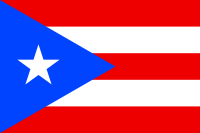Portal:Hispanic and Latino Americans
Welcome to the Hispanic and Latino Americans portalHispanic and Latino Americans (Spanish: Estadounidenses hispanos y latinos; Portuguese: Estadunidenses hispânicos e latinos) are Americans of Spanish and/or Latin American background, culture, or family origin. These demographics include all Americans who identify as Hispanic or Latino regardless of race. As of 2020, the Census Bureau estimated that there were almost 65.3 million Hispanics and Latinos living in the United States and its territories. "Origin" can be viewed as the ancestry, nationality group, lineage or country of birth of the person or the person's parents or ancestors before their arrival in the United States of America. People who identify as Hispanic or Latino may be of any race, because similar to what occurred during the colonization and post-independence of the United States, Latin American countries had their populations made up of descendants of white European colonizers (in this case Portuguese and Spaniards), Native peoples of the Americas, descendants of African slaves, post-independence immigrants coming from Europe, Middle East and East Asia, as well as descendants of multiracial unions between these different ethnic groups. As one of the only two specifically designated categories of ethnicity in the United States, Hispanics and Latinos form a pan-ethnicity incorporating a diversity of inter-related cultural and linguistic heritages, the use of the Spanish and Portuguese languages being the most important of all. Most Hispanic and Latino Americans are of Mexican, Puerto Rican, Cuban, Salvadoran, Dominican, Colombian, Guatemalan, Honduran, Ecuadorian, Peruvian, Venezuelan or Nicaraguan origin. The predominant origin of regional Hispanic and Latino populations varies widely in different locations across the country. In 2012, Hispanic Americans were the second fastest-growing ethnic group by percentage growth in the United States after Asian Americans. (Full article...) Selected article Puerto Rico (Spanish for "rich port") is an archipelago that includes the main island of Puerto Rico and a number of smaller islands, the largest of which are Vieques, Culebra, and Mona. The main island of Puerto Rico is, by land area, the smallest of the Greater Antilles. With around 3.6 million people, it ranks third in population among that group of four islands, which include Cuba, Hispaniola (Dominican Republic and Haiti), and Jamaica. The capital and largest city is San Juan. Due to its location, Puerto Rico has a tropical climate and is subject to hot weather all-year-round. The national language is Spanish but English is recognized as an official language as well. (more...) Selected image Photo of John Gavin as Harrison Destry from the short-lived television series Destry (1964) image credit: publicity photograph
Did you know...
January - June 2014 Things you can do
Selected biography Following the closure of the Black Cat in 1964, Sarria went to work with restaurateur Pierre Parker. The pair operated French restaurants at World's Fairs. While at the 1964 New York World's Fair, Sarria learned that Jimmy Moore had committed suicide. Sarria worked at several more Fairs before retiring in 1974. After living with Parker in Phoenix, Arizona for several years, Sarria returned to San Francisco. He continued to reign over the Courts for 43 years, before abdicating in 2007. For his lifetime of activism, the city of San Francisco renamed a section of 16th Street in Sarria's honor. (more...) SubcategoriesRelated PortalsAssociated WikiProjects
Hispanic and Latino American TopicsAfro-Latin American | Asian Hispanic and Latino Americans | Black Hispanic and Latino Americans | Californio | Chicano | Cuban American | Demographics of Hispanic and Latino Americans | Hispanic | Hispanic Americans in World War II | Hispanic and Latino Americans | Hispanic–Latino naming dispute | Hispanos | Latino | List of Hispanic and Latino Americans | MEChA | Mexican American | Puerto Rican people | Spanish language in the United States | Tejano | White Hispanic and Latino Americans Associated WikimediaThe following Wikimedia Foundation sister projects provide more on this subject:
Discover Wikipedia using portals |






















